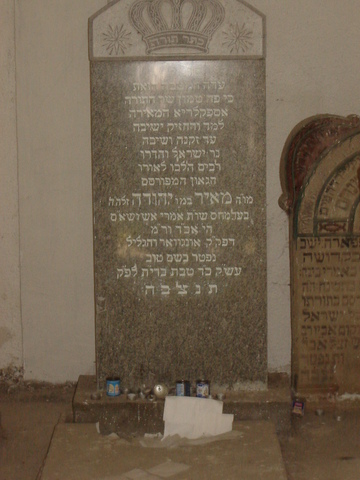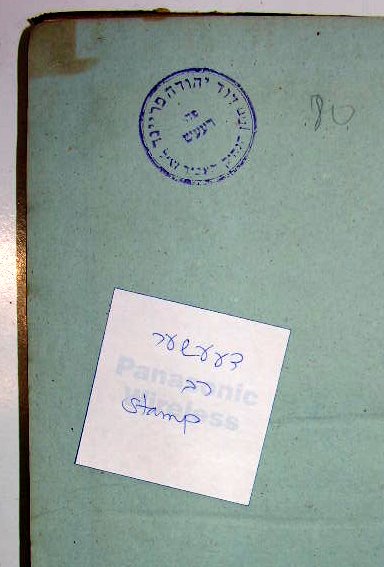Meir Eisenstadter
Meir ben Judah Leib Eisenstädter (1780-1852)
Rabbi Meir Eisenstädter (or Meir Eisenstadt) z'tl (born in 1780 or 1786, in Schossberg (Sasvár, today Šaštín–Stráže, Slovakia) - died in 1852, according to other sources, 2nd December 1861.) in Uzhgorod (Ungvár, The Ukraine) - also known as Meir Asch - or the Maharam Asch (which is the acronym of the Hebrew expression: " our teacher, Rabbi Meir Eisenstadt" = "Morenu ha-Rav Meir Eisenshtadt" ), one of the greatest Talmudist of the 19th century, rabbi, and a liturgic poet (paytan). He also was called as Meir Gyarmath and Meir Ungvar after his later rabbinates. In his youth he moved to Eisenstadt (Kismarton), from which he took his name.
He studied at the yeshiva of Mattersdorf (Nagymarton, Burgenland) as the pupil of the greatest and still the most famous rabbi of the age, who became later the chief rabbi of Pressburg (Pozsony, now Bratislava, Slovakia) Moses Schreiber, the "Chatam Sofer". He was married to the daughter of the rabbi of Nove Mesto (Vágújhely, Slovakia), David Deutsch, where he was appointed the head of the yeshiva.
He was called to the rabbinate of Baja in 1807, where he directed a large yeshiva. He was the intimate friend of Rabbi Götz Schwerin Kohn, who became later the Chief Rabbi of County Bács. When Schwerin was, through the ruin of his father-in-law, compelled to seek a rabbinate, Eisenstadt voluntarily resigned to him the office at Baja, and on the recommendation of the Chatam Sofer, obtained a position at Balassagyarmat, where he served between 1815-1835. Then he removed to Ungvár, where he hold the position of the Chief Rabbi, until his death. He was regarded as the leading rabbi of Hungary. In Ungvar, too, he headed a large yeshiva and many of the future rabbis of Hungary were his pupils. He took an active part in the communal life of the Hungarian Jewry and exercised a profound influence on the course it was to take. He vehemently opposed the progressives who desired to introduce religious changes and reforms. The greatest rabbis of Hungary and Galicia including R. Solomon Kluger of Brod, R. Ḥayyim Halberstam of Neu Sandec (Nowy Sacz, Poland), and R. Simon Sofer of Cracow addressed problems to him. Rabbi Shlomo Ganzfried, author of the Kitzur Shulchan Aruch (the summary of the Sulchan Aruch, which is still one of the most popular codebooks of the Orthodox Jewry) served as Dayan (rabbinic judge) during this time in Ungvár.
After the death of Rabbi Eisenstadt, his son, Rabbi Menachem Asch followed him as rabbi in Ungvár. It is worth mentioning that on 24 April 1869, there was a visiting delegation of Orthodox rabbis to the Emperor and King, Franz Joseph I in the Royal Palace of Buda, where Rabbi Ktav Sofer (son of the Chatam Sofer) of Pozsony (Bratislava), Rabbi Menachem Asch of Ungvár, Rabbi Menachem Katz of Deutschkreutz (Németkeresztúr, Burgenland, Austria) and Rabbi Aharon David Deutsch of Balassagyarmat were present.
His major work, "Imrei Esh" (it means: "words of fire" - it's an equivoke as the abbreviation of Eisenstadt, E.S means "fire" in Hebrew), which contains his responsa (rabbinic answers to halachic, ie. jewish religious questions), was published by his son in two parts: "Imrei Yosher" (Words of Honesty), sermons, (Ungvár 1864), and "Imrei Binah" (Words of Wisdom) halachic novellae on Seders of "Mo'ed" (Festivals) and "Nashim" (Women) (1866)
Sources:

- Hungarian Jewish Lexicon. Ed. Péter Ujvári. Budapest: Magyar Zsidó Lexikon. 1929. p. 76. Reach online
The book "Imrei Binah" is fully available on ![]()
The book "Imrei Esh" is fully available on ![]()
(Yechiel)







